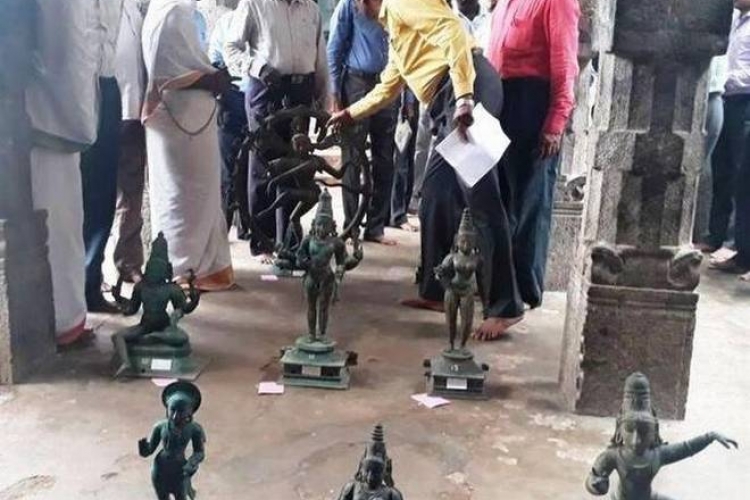IDOL THEFT
IN NEWS
A Division Bench of Justices raised the question during the hearing of an anticipatory bail application filed by Chennai-based businesswoman Kiran Velagapudi (Kiran Rao) in a case booked against her pursuant to seizure of 23 stone sculptures from her residence here recently.
The Madras High Court wanted to know under what authority the Idol Theft Wing CID was seizing antiquities when Section 23 of the Act, aimed at preventing smuggling and fraudulent dealings, confers the power only on officers authorized by the Centre.
The court also directed idol wing chief Pon Manickvel, IPS to provide a list of temples where apprehension of idols thefts was more while asking the government what action it had taken against the officials who were alleged to have been involved in such thefts.
ANTIQUITIES TREASURIES AND ART ACT 1972
The Antiquities and Art Treasures Act, 1972 was enacted with an objective to control the export business in the treasures of antiquities and sculptures, to avoid smuggling and fraudulent commercial activities in the antiques, to necessarily acquire antiquities and sculpture for conservation and for other issues related with the subject.
The Act makes it unlawful except the Central Government or the authorized person to export the objects that are historic art treasure. The Central Government or authorized person shall export the antiquity only as per the stipulations and terms of permit provided by the prescribed authority. As per Section 24 of the 1972 Act, antiquity of an object could be determined only by the Director General of Archaeological Survey of India or an officer nominated by him/her.
However, in the present case, Idol Theft Wing officials had obtained an opinion from a retired Director of ASI and such a course was impermissible.
ARCHEOLOGICAL SURVEY OF INDIA
The Archaeological Survey of India (ASI), under the Ministry of Culture, is the premier organization for the archaeological researches and protection of the cultural heritage of the nation.
Antiquity Section is entrusted with the responsibility of implementing the Antiquities and Art Treasures Act, 1972 enacted by the Parliament which came into force with effect from 5th April, 1976 to regulate the export trade in antiquities and art treasures, to provide for the prevention of smuggling and fraudulent dealings in antiquities, to provide for the compulsory acquisition of antiquities and art treasures for preservation in public places and to provide for certain other matters connected therewith .
Under section 3 of the Antiquities and Art Treasures Act 1972 no person other then the Central Government or any authority or agency authorized by the Central Government in this behalf to export any antiquity or art treasures.
In case there is any question about the authenticity of the art object, the Director General, ASI has the power to determine whether or not an article is an antiquity or art treasures. Whenever, any object is seized by any enforcing agency, the same is presented before the Director General, ASI to examine it under section 24 of the AAT Act, 1972 and accordingly further action is taken by enforcing agencies.
NEED FOR REFORMS
- Registering antiquities with the Archaeological Survey of India (ASI) has long been a cumbersome and difficult procedure for most collectors, with the state simply not equipped to handle the needs of a growing populace of collectors.
- The other is the rule that every object over 100 years is an antique. But adding the idols age alone cannot constitute a work of art or a national treasure.
- To promote a view that once sacred objects today only belong to temples and thus deny the process of regeneration of these living cultural sites is a shirt sighted view stemming from a lack of understanding of the role and purpose of these objects, the temple economy that maintained them, and also the constant process of renewal that occurred within historic sites.
- The question is that whether the states are equipped to handle and maintain this vast emerging enterprise as with every passing year, the number of objects that shift from 99th year to a 100 year status will soon result in the transfer of vast numbers of objects to a status of national antiquity.
Analysis:
Cultural vigilantism and the presumption of guilt without trial, public shaming and the resultant media trial have led to a state of affairs that is dangerous — casting a long shadow on the production of knowledge of our past.
The role of private connoisseurship, individual collectors, trusts and foundations can be channeled here. It is well within the rights of every citizen to acquire and collect objects of their past that they feel imparts a sense of memory, history and an understanding of our culture. What should definitely govern this acquisition is a legal process of buying.
A civilisational history cannot be constructed purely by an archaeological agency. While it is an important component, other groups such as littérateurs, historians, anthropologists and curators also contribute valuable insights into our material culture. However, the framing of our laws has not happened in conjunction with any of these disciplines. A need of reform for the existing law is the need of the hour to save our material culture from being examined purely from the prism of religious sentiment and to foster the creation of secular spaces where everyone can enjoy and appreciate our past.


 IAS -2025 Prelims Combined Mains Batch - III Starts - 14-04-2024
IAS -2025 Prelims Combined Mains Batch - III Starts - 14-04-2024